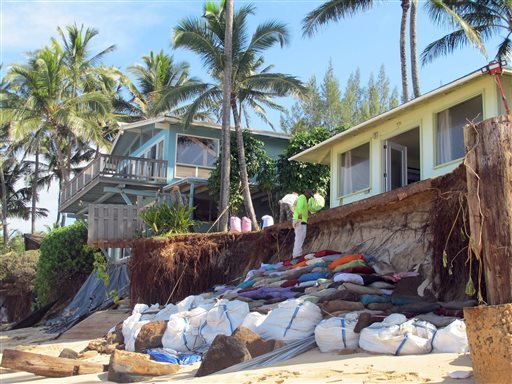HONOLULU — More than 13 miles of Hawaii beaches have been lost to erosion in the past century, and lawmakers are tackling the problem by attempting to secure more money for beach restoration. ADVERTISING HONOLULU — More than 13 miles
HONOLULU — More than 13 miles of Hawaii beaches have been lost to erosion in the past century, and lawmakers are tackling the problem by attempting to secure more money for beach restoration.
Chronic erosion is affecting 70 percent of beaches on Oahu, Kauai and Maui, according to a study by the U.S. Geological Survey.
“That’s just the tip of the iceberg,” said Sam Lemmo, administrator for Hawaii’s Office of Conservation and Coastal Lands. “Most of the beaches in the state are on an erosion basis now, and that’s only going to increase in the future with sea level rise. It’s going to double, it’s going to possibly triple, by the end of the century.”
A study by the University of Hawaii released Monday indicated that coastal erosion of Hawaii’s beaches could double by mid-century. Following current trends, the shoreline could recede by an average of 20 feet in 2050 or 40 feet by 2100, according to the report.
A bill in the Legislature would set aside part of the transient accommodation tax to help fund beach restoration. The bill is supported by the Hawaii Tourism Authority, which has an obvious interest in ensuring that beaches aren’t lost.
“It is one of the most important things that we need to focus in on, because we are known for our beautiful beaches, our sand, our environment,” said Senate President Donna Mercado Kim, “and if that should go, that would be so detrimental to the economy and to the environment.”
The dollar amount for beach restoration in the bill is currently blank, and Kim said she’s hoping for $3 million to $5 million a year for what would be a new beach restoration and conservation special fund.
Kim’s proposal in the Senate, SB 617, died, but a companion measure introduced in the House is alive. A joint Senate panel approved that bill, HB 444, on Monday.
“Our beaches are so vital to not only our visitors, but to our local families,” said Rep. Ryan Yamane, who introduced HB 444. Yamane is hoping for $5 million for the beach restoration fund.
The bill would give the Department of Land and Natural Resources a foundation for a program to sustain beach management, Lemmo said.
“The erosion rate is going to be horrendous,” Lemmo said. “We have to adjust or adapt to those rapid changes that are going to be occurring because of rapid sea level rise. We need to have a total package, not just like throw sand on the beach.”
The construction of sea walls and buildings that are too close to the shore may be contributing to the problem. If the bill passes, the department could devote more resources to addressing erosion through planning, building setbacks and ordinances that would guide future development, Lemmo said.
The Tax Foundation of Hawaii opposed the bill, arguing that earmarks decrease government accountability and should be avoided.
Having dedicated funds would allow the department to act quickly, instead of continually requesting legislative approval and waiting until later when it will cost more to fix problems, Kim said.
“It’s too much at stake,” Lemmo said. “It’s half of our economy.”



